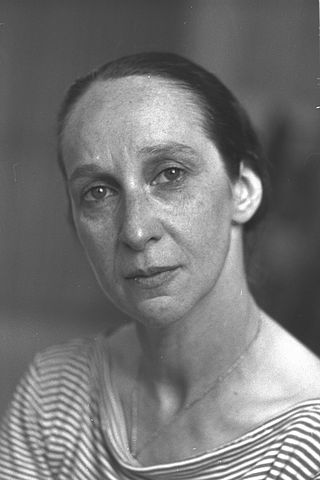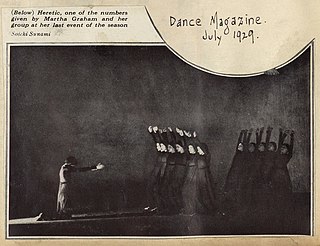Related Research Articles

Anna Sokolow was an American dancer and choreographer. Sokolow's work is known for its social justice focus and theatricality. Throughout her career, Sokolow supported of the development of modern dance around the world, including in Mexico and Israel.
Primitive Mysteries is a modern dance work choreographed by Martha Graham to music by Louis Horst. Graham also designed the original costumes. The piece premiered on February 2, 1931 at the Craig Theatre in New York City. From the first performance, critics hailed the ballet as a masterpiece and acknowledged Graham's rising role as a major force in American dance.
American Document is a modern dance work choreographed by Martha Graham in response to rising Fascism in 1930s Europe. The piece premiered on August 6, 1938 at the Vermont State Armory in Bennington, Vermont. The ballet features spoken word excerpts from the Declaration of Independence and Emancipation Proclamation, among other texts. The set was created by Arch Lauterer; the costumes were designed by Edythe Gilfond. The original music was written by Ray Green. Graham extensively reworked the choreography in 1989. John Corigliano's Oboe Concerto replaced Green's music for the revised version.

Heretic is a modern dance work by Martha Graham performed to Tetus Breton, an old folk tune from Brittany. Louis Horst, Graham's musical director, recommended the song, part of the collection Chansons de la Fleur de Lys as arranged by Charles De Sivry. The dance premiered with the title Heretic at New York's Booth Theatre on April 14, 1929. In a previous program announcement, the work was called A Faith. Graham presented the piece with her company; the performance marked the debut of her concert ensemble. Heretic is staged for 13 female performers, 12 dressed in black tube-like garments and one in a long white dress. Dancers for the premiere were: Graham, as the woman in white, Kitty Reese, Louise Creston, Irene Emery, Ethel Rudy, Lillian Ray, Hortense Bunsick, Sylvia Wasserstrom, Mary Rivoire, Ruth White, Lillian Shapero, Virginia Briton, Sylvia Rosenstein, Evelyn Sabin, Betty Macdonald and Rosina Savelli.
El Penitente is a modern dance work by Martha Graham performed to music by Louis Horst. It premiered on August 11, 1940, at the Bennington College Theater, Bennington, Vermont, with costumes by Edythe Gilfond and a set by Arch Lauterer. Isamu Noguchi later redesigned the set and created a new mask.
Land Be Bright is a modern dance work choreographed by Martha Graham to music by Arthur Kreutz with a set and costumes by Charlotte Trowbridge. The unabashedly patriotic piece premiered on March 14, 1942, at Chicago's Civic Opera House. The original cast included Graham and members of the Martha Graham Dance Company.
Columbiad is a solo modern dance choreographed by Martha Graham to music by Louis Horst. Edythe Gilfond designed the costume; Philip Stapp created the set. The ballet premiered on December 27, 1939, at the St. James Theatre in New York City. Columbiad's debut was part of an event called the Holiday Dance Festival, which included four additional works by Graham and pieces by the American Ballet Caravan, Carmalita Maracci and Dance Group, and Korean modern dancer Sai Shoki.
Maple Leaf Rag is a storyless Martha Graham ballet set to ragtime compositions by Scott Joplin. The work premiered on October 2, 1990 at New York City Center with costumes by Calvin Klein and lighting by David Finley. Chris Landriau arranged the music and played piano at the debut. The dance is a jubilant self-parody and an homage, of sorts, to Graham's mentor and musical director, Louis Horst, who would play the rag for her whenever she fell into a creative slump. Graham was 96 when she created Maple Leaf Rag; it is her last completed dance. In 1991, she began another work, The Eyes of the Goddess, but it was unfinished at the time of her death.
Insincerities, also known as Four Insincerities, is a solo modern dance work created by Martha Graham. The piece consists of four sections: Petulance, Remorse, Politeness and Vivacity performed to music by Serge Prokofiev. It premiered on January 20, 1929, at the Booth Theatre in New York City. Louis Horst accompanied Graham on piano.
Frontier is a solo dance choreographed by Martha Graham to music by Louis Horst. The set was designed by Isamu Noguchi; Graham created the costume. The work began as an ensemble piece, Perspectives: Frontier and Marching Song also known as Frontiers and Frontier. The ballet's Marching Song portion was set to music by Lehman Engle. The work premiered on April 28, 1935, at the Guild Theatre in New York City. By the end of 1935, Graham was performing Frontier exclusively as a solo. The piece was the first of her works to explore American identity through an archetypal character.
Immediate Tragedy, sometimes subtitled Dance of Dedication, was a modern dance solo choreographed by Martha Graham to the music of Henry Cowell. It premiered on July 30, 1937, at the Bennington School of the Dance in Bennington, Vermont. The piece was created in response to the Spanish Civil War and rising fascism as Francisco Franco gained control of the country.
Deep Song, a solo modern dance by Martha Graham, premiered on December 19, 1937, at the Guild Theatre in New York City. Performed to music by Henry Cowell, the piece was the second work created by Graham in response to the Spanish Civil War. The first, Immediate Tragedy, was introduced in 1937.
Vision of the Apocalypse was a modern dance created by Martha Graham to music by Hermann Reutter. It premiered on April 14, 1929, at the Booth Theatre in New York City. The occasion marked the debut of Martha Graham and Group, Graham's new concert ensemble and the predecessor to the Martha Graham Dance Company. Vision of the Apocalypse was the first piece Graham choreographed for a large group.
Danza was a modern dance solo choreographed and danced by Martha Graham to music by Darius Milhaud. It premiered on March 3, 1929, at the Booth Theatre in New York City.
Moment Rustica was a Martha Graham ballet performed to the music of Francis Poulenc. It premiered on April 14, 1929, at the Booth Theater in New York City. The performance marked the debut of Graham's concert ensemble, Martha Graham and Group, the predecessor of the Martha Graham Dance Company.
Adolescence (Prelude and Song) was an early modern dance solo choreographed by Martha Graham to music by Paul Hindemith. It premiered on March 2, 1929, at the Booth Theatre in New York City.
Chronicle is a modern dance work choreographed by Martha Graham to music by Wallingford Riegger. It premiered on December 20, 1936, at the Guild Theatre in New York City. The set was designed by Isamu Noguchi. Riegger's music was scored for piano, wind instruments and percussion; Noguchi's set was made up primarily of curtains, platforms and stairs. The original production was danced by Martha Graham and Group, the forerunner of the Martha Graham Dance Company. According to the program notes, the dance is based upon "the advent and consequences of war" and concerned itself with the "contemporary situation", referring to the impending conflict in Europe.
Course was a modern dance work choreographed by Martha Graham to music by George Antheil. The piece sometimes appeared on programs as Course: One in Red; Three in Green; Two in Blue; Two in Red. It premiered on February 10, 1935, at the Guild Theatre in New York City. The ballet was performed by Martha Graham and Group, the forerunner to the Martha Graham Dance Company.
American Lyric was a modern dance work choreographed by Martha Graham to music of Alex North with costumes by Edythe Gilfond. The piece premiered on December 26, 1937, at the Guild Theatre in New York City. The ballet was subtitled Dance of Assembly. In some programs, the work also included the statement, "This dance has as its theme the basic American right—freedom of assembly."
Salutation was a modern dance solo choreographed by Martha Graham to music by Lehman Engel. It premiered on April 7, 1936, at Philharmonic Auditorium in Los Angeles, California. Subtitled Dance of Greeting, the work was performed by the choreographer.
References
- 1 2 "Horizons (Ballet choreographed by Martha Graham)". Performing Arts Encyclopedia, Library of Congress. Retrieved 4 February 2016.
- 1 2 3 "Martha Graham Gives New Dance, "Horizons"". New York Post. February 23, 1936. Retrieved 4 February 2016.
- 1 2 G, H (April 1936). "Dance Reviews, Martha Graham and Dance Group". Dance Observer. Retrieved 4 February 2016.
- ↑ Snodgrass, Mary Ellen (2015). The Encyclopedia of World Ballet (Hardback ed.). Rowman & Littlefield. p. 142. ISBN 978-1-4422-4525-9.
- 1 2 Mansfield Soares, Janet (1992). Louis Horst: Musician in a Dancer's World (1st ed.). Duke University Press. pp. 123–124. ISBN 0-8223-1226-3.
- ↑ "Review of Martha Graham performance of February 23, 1936". New York Herald Tribune. February 24, 1936. Retrieved 4 February 2016.
- ↑ McCausland, Elizabeth (March 1, 1936). "Definite Charm in Graham's Art". Springfield Union. Retrieved 4 February 2016.
- 1 2 Martin, John (February 24, 1936). "Martha Graham's Recital". The New York Times. Retrieved 4 February 2016.